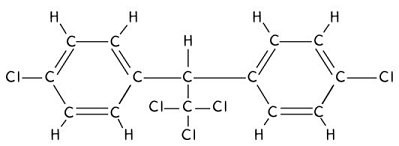The extremely low surface temperatures in the Antarctic in July (Southern Hemisphere winter) clearly demonstrate the influence of _______.
A - ocean currents
B - aphelion
C - lapse rates
D - adiabatic cooling
E - greater cooling of land than water
E - greater cooling of land than water
You might also like to view...
 DDT, C14H9Cl5, is a very effective insecticide. It is hazardous to other species, however, because it tends to accumulate in the food chain. Shown above is its chemical structure. Suggest why it remains on plants and in soils for extended periods of time.
DDT, C14H9Cl5, is a very effective insecticide. It is hazardous to other species, however, because it tends to accumulate in the food chain. Shown above is its chemical structure. Suggest why it remains on plants and in soils for extended periods of time.
What will be an ideal response?
The monsoon winds in summer:
a. move from the oceans over the land. b. occur only on middle latitude west coasts. c. flow from land toward the oceans. d. are a main feature of the world-wide zonal pattern of circulation.
The Atlantic Multidecadal Oscillation (AMO) is a reasonably distinct pattern of alternating times ________.
A. of sea ice formation and melting in the North Atlantic Ocean B. of high and low pressure in the North and South Atlantic Ocean C. of El Niño and La Nin?a affecting Atlantic Ocean surface currents D. of colder versus warm water in the North Atlantic Ocean E. of sunspots and solar flares affecting sea-surface temperatures in the North Atlantic Ocean
In terms of erosion, a gulley is a larger example of a feature called a(n) ________
A) dendritic pattern B) rill C) radial D) alluvial fan E) interfluve